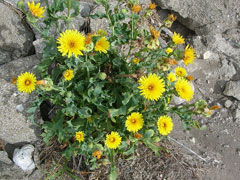 |
|
http://www.hear.org/starr/ |
 |
|
Translate this page:
Summary
Physical Characteristics

 Reichardia_picroides is a PERENNIAL growing to 0.5 m (1ft 8in) by 0.3 m (1ft).
Reichardia_picroides is a PERENNIAL growing to 0.5 m (1ft 8in) by 0.3 m (1ft).
See above for USDA hardiness. It is hardy to UK zone 8 and is not frost tender. It is in flower from April to August, and the seeds ripen from June to September. The species is hermaphrodite (has both male and female organs) and is pollinated by Insects.
Suitable for: light (sandy), medium (loamy) and heavy (clay) soils and prefers well-drained soil. Suitable pH: mildly acid, neutral and basic (mildly alkaline) soils. It can grow in semi-shade (light woodland) or no shade. It prefers moist soil.
UK Hardiness Map
US Hardiness Map
Synonyms
R. macrophylla. Picridium vulgare.
Plant Habitats
Edible Uses
Leaves - raw or cooked[2, 27, 37, 52, 105]. Mild and good[37]. A pleasant agreeable flavour with a slight sweetness and very little fibre, it makes a very acceptable lettuce substitute and we use it in large quantities in salads[K]. The older leaves seem to be even nicer, even when the plant is in flower[K]. Root - raw or cooked[2, 177, 183].
References More on Edible Uses
Medicinal Uses
Plants For A Future can not take any responsibility for any adverse effects from the use of plants. Always seek advice from a professional before using a plant medicinally.
None known
References More on Medicinal Uses
The Bookshop: Edible Plant Books
Our Latest books on Perennial Plants For Food Forests and Permaculture Gardens in paperback or digital formats.

Edible Tropical Plants
Food Forest Plants for Hotter Conditions: 250+ Plants For Tropical Food Forests & Permaculture Gardens.
More

Edible Temperate Plants
Plants for Your Food Forest: 500 Plants for Temperate Food Forests & Permaculture Gardens.
More

More Books
PFAF have eight books available in paperback and digital formats. Browse the shop for more information.
Shop Now
Other Uses
References More on Other Uses
Cultivation details
Easily grown in any moderately fertile well-drained soil in a sunny position[200]. Grows best in a shady position in summer[37], where it will produce better quality leaves[K]. It prefers plenty of moisture in the growing season[200], though it is fairly drought tolerant once established[K]. Plants are very tolerant of poor soils[K]. This species is not hardy in the colder areas of the country, it tolerates temperatures down to between -5 and -10°c[200]. It is likely to be hardier when grown in a soil on the poor soil, though the leaves will not be so tender nor so freely produced[K]. Plants are also likely to be hardier in well-drained soils and dislike very wet weather[K]. Plants are often short-lived, though they are self-sowing quite freely in Cornwall[K]. A very easily grown plant, it has also proved to be almost totally slug-proof, even in a very heavily slug-infested garden[K]. Formerly cultivated as a cut and come again salad crop in S. Europe[27, 37], producing a harvestable yield within 10 weeks of sowing the seed[K]. This plant is possibly useful as a winter salad crop, growing in a sunny fairly sheltered position in Cornwall it has been yielding very well and continuously for a period of 18 months since the summer of 1993[K]. It requires more investigation[K].
References Carbon Farming Information and Carbon Sequestration Information
Temperature Converter
Type a value in the Celsius field to convert the value to Fahrenheit:
Fahrenheit:
The PFAF Bookshop
Plants For A Future have a number of books available in paperback and digital form. Book titles include Edible Plants, Edible Perennials, Edible Trees,Edible Shrubs, Woodland Gardening, and Temperate Food Forest Plants. Our new book is Food Forest Plants For Hotter Conditions (Tropical and Sub-Tropical).
Shop Now
Plant Propagation
Seed - sow March/April in a warm position outdoors and then in succession if required until the autumn. Only just cover the seed. Germination is usually very good and quick. We usually make a sowing in the spring in the greenhouse, pricking out the seedlings into individual pots as soon as they are large enough to handle, and then planting them out in late spring or early summer. Established plants can self-sow quite freely in disturbed ground.
Other Names
If available other names are mentioned here
Native Range
TEMPERATE ASIA: Lebanon, Syria, Turkey,Cyprus. EUROPE: Albania, Bulgaria, Bosnia and Herzegovina, Greece, Croatia, Italy, North Macedonia, Malta, Montenegro, Slovenia, Spain, France, Gibraltar, Monaco, Portugal, AFRICA: Algeria, Egypt, Libya, Morocco, Tunisia.
Weed Potential
Right plant wrong place. We are currently updating this section.
Please note that a plant may be invasive in one area but may not in your area so it’s worth checking.
Conservation Status
IUCN Red List of Threatened Plants Status :

Growth: S = slow M = medium F = fast. Soil: L = light (sandy) M = medium H = heavy (clay). pH: A = acid N = neutral B = basic (alkaline). Shade: F = full shade S = semi-shade N = no shade. Moisture: D = dry M = Moist We = wet Wa = water.
Expert comment
Author
(L.)Roth.
Botanical References
50200
Links / References
For a list of references used on this page please go here
Readers comment